

There is some debate as to the location of the geographical centre of Scotland. This is due to different methods of calculating the centre, and whether surrounding islands are included.


There is some debate as to the location of the geographical centre of Scotland. This is due to different methods of calculating the centre, and whether surrounding islands are included.
In 2002, the Ordnance Survey calculated the centre using a mathematical centre of gravity method. This is the mathematical equivalent of calculating the point at which a cardboard cut-out of Scotland could be perfectly balanced on the tip of a pin. It becomes complicated when the islands are included so one simplification is just to ignore them.

The Ordnance Survey calculated that the centre of Mainland Scotland is at NN7673153751 ( 56°39′33.86″N4°0′40.37″W / 56.6594056°N 4.0112139°W ). The point is 5 km east of the mountain of Schiehallion, which is sometimes claimed to be at the centre of Scotland.
The centre point including islands was found to be at grid reference NN6678471599 ( 56°49.0153′N4°10.959′W / 56.8169217°N 4.182650°W Coordinates: 56°49.0153′N4°10.959′W / 56.8169217°N 4.182650°W ). This is on a hillside near Loch Garry, between Dalwhinnie and Blair Atholl and close to the A9 road and the railway line. [1] [2]
Nearby, it is claimed that the centre lies a few miles from the village of Newtonmore, Badenoch. It is marked by a stone set into a wall. [3]
Another cruder method is to take the intersection between the line of latitude midway between the most northerly and southerly points on the Scottish mainland, and the line of longitude midway between the most easterly and westerly points. In the days when Corrachadh Mòr in Ardnamurchan was undisputedly the most westerly point, this also produced 56 degrees 39 minutes N, 4 degrees 0 minutes W, very near the summit of Schiehallion.
However the construction of the Skye Bridge, arguably turning Skye into part of the Scottish mainland, may have upset some of these calculations.

Less credible candidates for the centre of Scotland also exist. The Society of Antiquaries of Scotland in 1908 suggested the megalithic Faskally Cottages Standing Stones. [4] The Society were aware of other contenders of the centre of Scotland: "Various spots have been so designated: a site at Struan, several miles to the N.W. of Faskally; also a house on the Killiecrankie road, being the most talked of besides a house in the Fair City of Perth itself." [5]
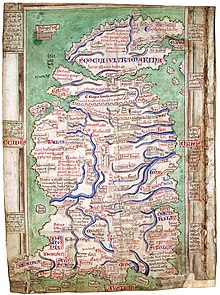
Matthew Paris's map of 1247 shows a clear north–south divide to Scotland. Proverbially Stirling is the strategically important "Gateway to the Highlands". It has been said that "Stirling, like a huge brooch clasps Highlands and Lowlands together". [6] [7] There is also and east–west divide as told in the story as recorded by Boece who relates that in 855 Scotland was invaded by two Northumbrian princes, Osbrecht and Ella. [8] They united their Northumberian Anglian forces with the Lowland Strathclyde Britons in order to defeat the Highland Pictish Scots. Having secured Stirling castle, they built the first stone bridge over the Forth. On the top they reportedly raised a crucifix with the inscription: "Anglos, a Scotis separat, crux ista remotis; Arma hic stant Bruti; stant Scoti hac sub cruce tuti." [9] It may be the stone cross was a tripoint for the three kingdom's borders or marches. [10] In this way the stone cross in the centre of Stirling Bridge was the heart of Scotland. [11]


The centre of the Central Belt may also be a point of interest. The Heart of Scotland services known as Harthill is close to the centre of the M8 motorway, Scotland's main road linking East with West. Cumbernauld, also in the Central Belt, is a watershed with one of its rivers (from which its name is derived) flowing to the east and the other flowing west. This watershed test could also apply to other sites like the summit of Ben Lomond being on the line of the Scottish watershed but Cumbernauld arguably has this property in its very name. A map of Scotland's watershed has been produced for walkers. [12]
There have been other centres suggested, such as the furthest point from salt water including sea lochs. The point furthest from the Mean High Water mark is in Glen Quoich, near Braemar, in Aberdeenshire which is 67.6 km from the sea. [13] [14]
As with other topics like defining the location of the North Pole the answer largely depends on which criteria you choose.

Some have also claimed Gartincaber Tower [15] for the title. [16] Even some Stirlingshire residents consider it ahead of Stirling Bridge. [17]

Stirling is a city in central Scotland, 26 miles (42 km) northeast of Glasgow and 37 miles (60 km) north-west of Edinburgh. The market town, surrounded by rich farmland, grew up connecting the royal citadel, the medieval old town with its merchants and tradesmen, the Old Bridge and the port. Located on the River Forth, Stirling is the administrative centre for the Stirling council area, and is traditionally the county town of Stirlingshire. Proverbially it is the strategically important "Gateway to the Highlands".
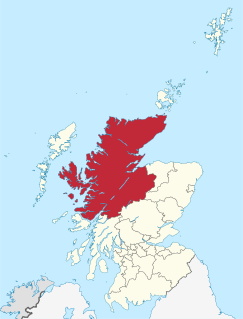
Highland is a council area in the Scottish Highlands and is the largest local government area in the United Kingdom. It was the 7th most populous council area in Scotland at the 2011 census. It shares borders with the council areas of Aberdeenshire, Argyll and Bute, Moray and Perth and Kinross. Their councils, and those of Angus and Stirling, also have areas of the Scottish Highlands within their administrative boundaries.

The Inner Hebrides is an archipelago off the west coast of mainland Scotland, to the south east of the Outer Hebrides. Together these two island chains form the Hebrides, which experience a mild oceanic climate. The Inner Hebrides comprise 35 inhabited islands as well as 44 uninhabited islands with an area greater than 30 hectares. Skye, Mull, and Islay are the three largest, and also have the highest populations. The main commercial activities are tourism, crofting, fishing and whisky distilling. In modern times the Inner Hebrides have formed part of two separate local government jurisdictions, one to the north and the other to the south. Together, the islands have an area of about 4,130 km2 (1,594 sq mi), and had a population of 18,948 in 2011. The population density is therefore about 4.6 inhabitants per square kilometre.

Scotland is a well-developed tourist destination, with tourism generally being responsible for sustaining 200,000 jobs mainly in the service sector, with tourist spending averaging at £4bn per year. In 2013, for example, UK visitors made 18.5 million visits to Scotland, staying 64.5 million nights and spending £3.7bn. In contrast, overseas residents made 1.58 million visits to Scotland, staying 15 million nights and spending £806m. In terms of overseas visitors, those from the United States made up 24% of visits to Scotland, with the United States being the largest source of overseas visitors, and Germany (9%), France (8%), Canada (7%) and Australia (6%), following behind.

Stirlingshire or the County of Stirling, Scottish Gaelic: Siorrachd Sruighlea) is a historic county and registration county of Scotland. Its county town is Stirling.
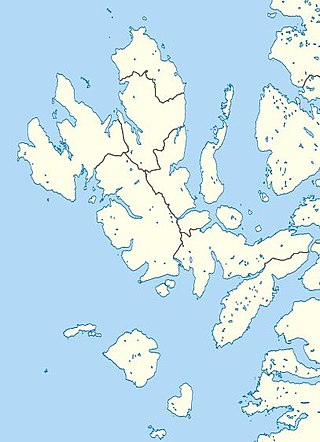
Sleat is a peninsula and civil parish on the island of Skye in the Highland council area of Scotland, known as "the garden of Skye". It is the home of the clan MacDonald of Sleat. The name comes from the Scottish Gaelic Slèite, which in turn comes from Old Norse sléttr, which well describes Sleat when considered in the surrounding context of the mainland, Skye and Rùm mountains that dominate the horizon all about Sleat.
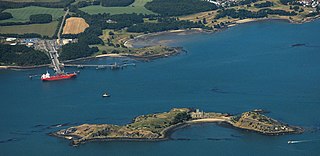
Inchcolm is an island in the Firth of Forth in Scotland. It was repeatedly attacked by English raiders during the Wars of Scottish Independence, and was fortified during both World Wars to defend nearby Edinburgh. Inchcolm now attracts visitors to its former Augustine Abbey.
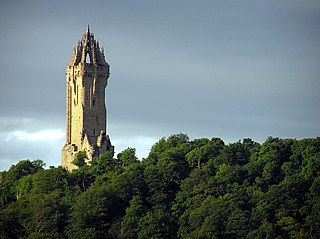
The National Wallace Monument is a 67 metre tower on the shoulder of the Abbey Craig, a hilltop overlooking Stirling in Scotland. It commemorates Sir William Wallace, a 13th- and 14th-century Scottish hero.

The Central Belt of Scotland is the area of highest population density within Scotland. Depending on the definition used, it has a population of between 2.4 and 4.2 million, including Greater Glasgow, Ayrshire, Falkirk, Edinburgh, Lothian and Fife.
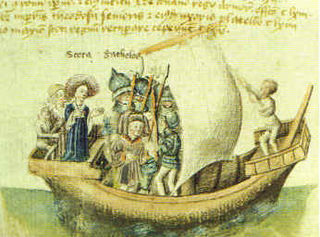
In medieval Irish and Scottish legend, Scota or Scotia is the daughter of an Egyptian pharaoh and ancestor of the Gaels. She is said to be the origin of their Latin name Scoti. Scholars believe she could be a fictional character who was named after the Scoti, rather than vice versa.
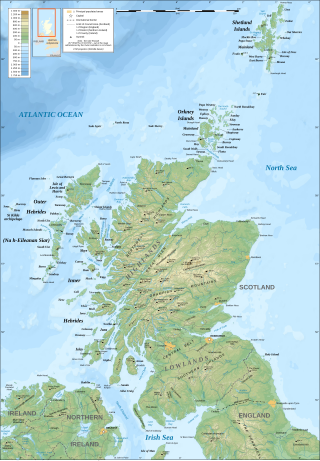
The geography of Scotland is varied, from rural lowlands to unspoilt uplands, and from large cities to sparsely inhabited islands. Located in Northern Europe, Scotland comprises the northern third of the island of Great Britain as well as 790 surrounding islands encompassing the major archipelagos of the Shetland Islands, Orkney Islands and the Inner and Outer Hebrides.
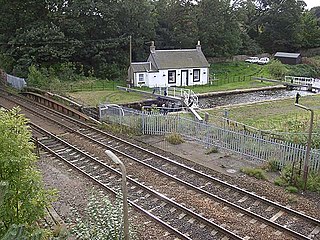
Camelon is a large settlement within the Falkirk council area, Scotland. The village is in the Forth Valley, 1.3 miles (2.1 km) west of Falkirk, 1.3 miles (2.1 km) south of Larbert and 2.6 miles (4.2 km) east of Bonnybridge. The main road through Camelon is the A803 road which links the village to Falkirk. At the time of the 2001 census, Camelon had a population of 4,508.
Christian Maclagan was a Scottish antiquarian and early archaeologist. She is known for her collection of rubbings of Celtic crosses and Pictish stones from across Scotland, and was a pioneer of stratigraphic excavation. Although she lost the use of her right hand due to a medical condition she nevertheless produced numerous drawings, sketches and paintings with her left hand. She took action to help those affected by poverty in Stirling. She refused to sit for portraits although one obituary described her as tall. She was a suffragist. She wrote an autobiography but the script remains lost. She was nominated to be one of Scotland's Heroines honoured at the National Wallace Monument's Hall of Heroes. She died in Ravenscroft, Stirling.

The Battle of Barry is a legendary battle in which the Scots, purportedly led by Malcolm II, defeated a Danish invasion force in 1010 AD. Its supposed site in Carnoustie, Angus can be seen in early Ordnance Survey maps. The history of the event relies heavily on tradition and it is considered to be apocryphal. The battle was named for the Parish of Barry, rather than the village, and was formerly thought to have taken place at the mouth of the Lochty burn, in the vicinity of the area that is now occupied by Carnoustie High Street. While the battle is not historically authentic, its romantic appeal continues to capture the popular imagination.
This is a list of the extreme points and extreme elevations in Scotland.
Camus, in historic literature, was a Scandinavian general dispatched to engage the Scots in battle, reportedly in the early eleventh century AD. The legendary engagement was called the Battle of Barry, and was first alluded to by Boece.
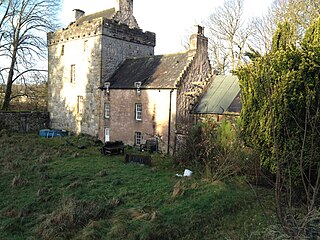
Castle Cary Castle is a fifteenth-century tower house, about 6 miles (10 km) from Falkirk, in the former county of Stirlingshire, Scotland. It is less than 3 miles from Cumbernauld Village. It is located near to the site of one of the principal forts of the Roman Antonine Wall.

The Aberlemno Sculptured Stones are a series of five Class I and II Early Medieval standing stones found in and around the village of Aberlemno, Angus, Scotland.

Cumbernauld Castle was the predecessor of Cumbernauld House in the Park in Cumbernauld. The Motte of the earliest castle survives, and stones of the second castle are incorporated in the present house.

The Red Burn is one of two main streams which flow out of Cumbernauld. The Scottish New Town’s name derives from the Gaelic for "the meeting of the waters" and there is broad agreement that one of these waters is the Red Burn.
{{cite book}}: |last2= has generic name (help)